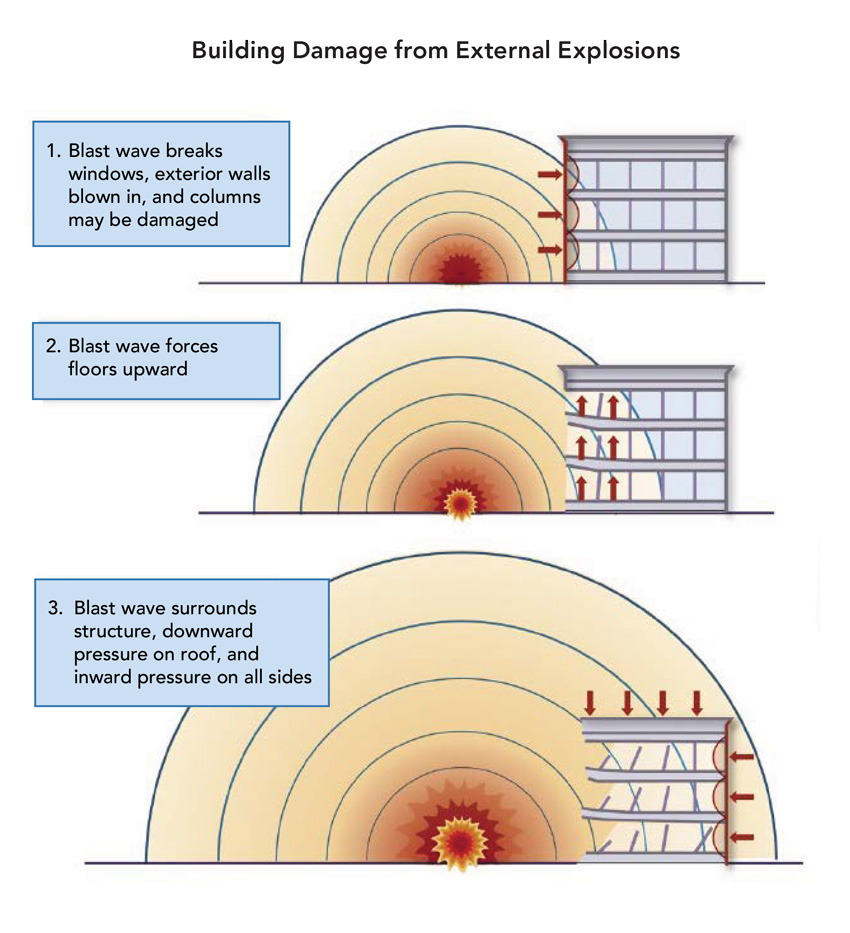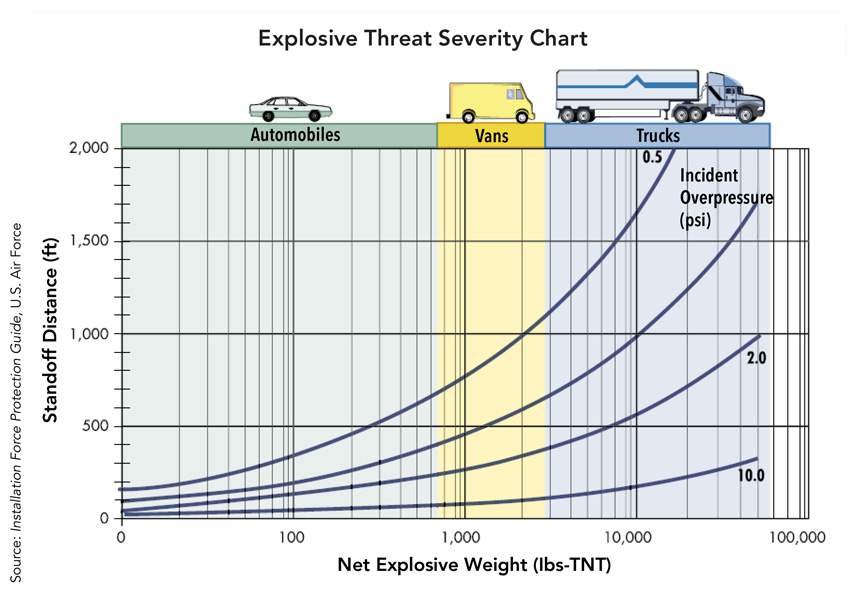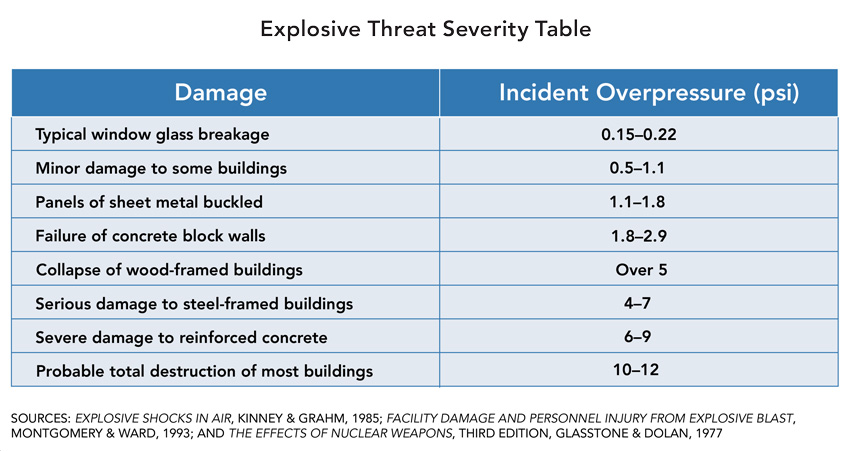Design to Protect
Criminal/Terrorist Threats
There are many natural risks to buildings, such as weather, earthquakes, or fire, but even when focusing only on potential threats caused by human intervention, the list is significant, from unauthorized entry to disrupted operations by insiders to cyber and information security threats. This course focuses on three major physical threats to building security:
Blast threats: Explosive events that can cause widespread primary and secondary damage.
Ballistic threats: Damage from projectiles fired from firearms.
Forced entry: Attack on a structure by mobs or other intruders.
The most effective—and also the most challenging—fenestration design resists combined threats, integrating some level of protection against all of these. In each case, there is a direct line between the design and construction of the fenestration systems and the safety of the building and its occupants. The following sections will explain in more detail the nature of each threat, how levels of severity and levels of protection are determined for each, and how fenestration systems can be evaluated for their performance in resisting these threats.
And all of these measures must be developed in the context of the building’s overall function and architectural appeal. In some facilities, part of the protective strategy may be in giving the building the definite appearance of a forbidding, hardened stronghold as a strong visual deterrent. But in the majority of buildings, aesthetic appeal is a high priority, and a welcoming, nonthreatening exterior is important to the work being done inside. The most effective products provide design flexibility, ensuring that a high level of physical security in a building does not require constructing a featureless fortress.
Blast Resistance
Designing fenestration systems that will resist explosive blast is a complex challenge. When designing for combined threats, it is the addition of blast resistance that often requires specialized engineering. Yet the challenge is unavoidable. Incendiary devices and explosives were the most common weapons used in the 280-plus terrorist attacks in the United States from 2001 to 2014, and these devices have tragically become almost commonplace in other parts of the world.1
Explosive devices are typically either borne by vehicles or placed or carried by a human (although they can also be sent through the mail), with the objective of destroying facilities and killing people within the blast area. The pressure waves created from detonation can result in many types of damage, including extensive glass breakage, buckling and failure of walls and columns, and even the immediate collapse of the structure and progressive collapse of nearby buildings (see Building Damage from External Explosions). Overpressure and airborne debris can cause significant human casualties, and the explosive fireball and resulting fires may cause additional damage.

Source: FEMA 428/BIPS 07: Primer to Design Safe School Projects in Case of Terrorist Attacks and School Shootings, Edition 2, January 2012
Some of the key terms for describing and measuring the threat include:
- Overpressure: the pressure caused by the shock wave over and above normal atmospheric pressure, in pounds per square inch (psi). For example, window glass breakage may occur at 0.15-0.22 psi incident overpressure, panels of sheet metal will be buckled at 1.1-1.8 psi, and most buildings will probably be totally destroyed at 10-12 psi incident overpressure.
- Standoff distance: Distance between the building, people, or other assets and the center of the explosive blast. Creating at least minimum stand-off distances is a basic protective measure since every additional foot of standoff distance will mitigate the severity of the blast pressure wave.
- Net explosive weight or weapon yield: generally expressed as equivalent pounds of TNT.
The Explosive Threat Severity Chart shows an example of the relationship of factors involved in describing the severity of explosive threats, such as the standoff distance, explosive weight, and general types of delivery vehicle.

Source: FEMA 428/BIPS 07: Primer to Design Safe School Projects in Case of Terrorist Attacks and School Shootings, Edition 2, January 2012
The Explosive Threat Severity Table gives examples indicating the correspondence of damage to buildings to the size of explosions expressed in terms of incident overpressure.

Source: FEMA 426: Reference Manual to Mitigate Potential Terrorist Attacks Against Buildings, December 2003
Blast resistance criteria have been developed by federal agencies, including the Department of State, General Services Administration, and the Department of Defense. ASTM has also developed a series of related standards that can be utilized to design and specify blast-resistant criteria for commercial structures and include ASTM F2912: Specification for Glazing and Glazing Systems Subject to Airblast Loadings and ASTM F2248: Practice for Specifying an Equivalent 3-Second Duration Design Loading for Blast Resistant Glazing Fabricated with Laminated Glass. In addition, an increasing number of large commercial projects are incorporating their own unique requirements for blast-resistant products.
Physical testing for blast resistance can be expensive and complex, requiring multiple samples and specialized equipment, such as outdoor shock tubes. But experienced manufacturers can contract with firms to perform engineering analyses for high-level blast loads.
To provide high levels of protection against high blast levels, all architectural features of the building must be hardened. For door and window systems, this primarily means sophisticated laminate systems: glass to absorb energy, and polycarbonate layers and coatings for flexure and protection.
The laminate is only one component of the system. One of the most important principles of blast-resistant design, as with design for other threats, is emphasis on the performance of the system as a whole, including the glazing, frames, and connectors or anchorage, as well as the reaction of adjacent elements in the building, such as walls and floors. For example, in an explosion, if a window system has a higher capacity than the supporting wall, when the wall fails, the entire window system may be blown into the facility.
Particularly in the case of blast resistance, reducing the level of protection will have a significant impact on the laminate construction, and thus on the cost of the overall system. For example, higher levels of protection typically require thicker laminates, heavier framing components, and anchors. Lowering the level of required protection may result in thinner glazing, lighter-weight framing, and lighter-weight or fewer connectors. But this is a sensitive balance. Blast overpressure transfers extremely high amounts of energy to the wall and adjacent structures, and all building components must be evaluated as a system in order to obtain confidence that a desired level of protection will be obtained.
This video contains a brief section of audio.
Video courtesy of Karagozian & Case
The test system shown in this short video was designed to withstand the effects of a significant blast. Note the blast wave as it impacts the structure and how quickly the blast occurs in real time.









